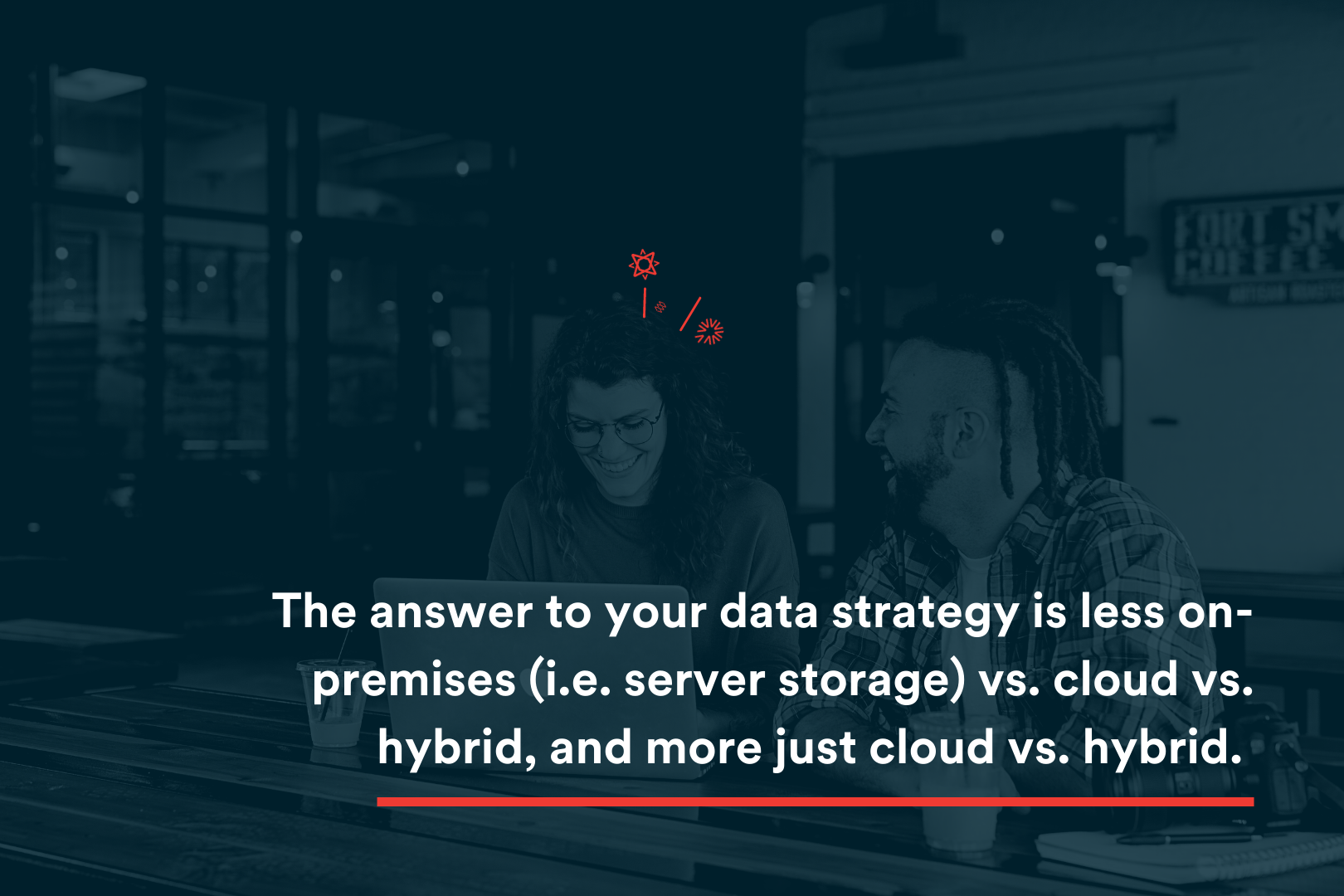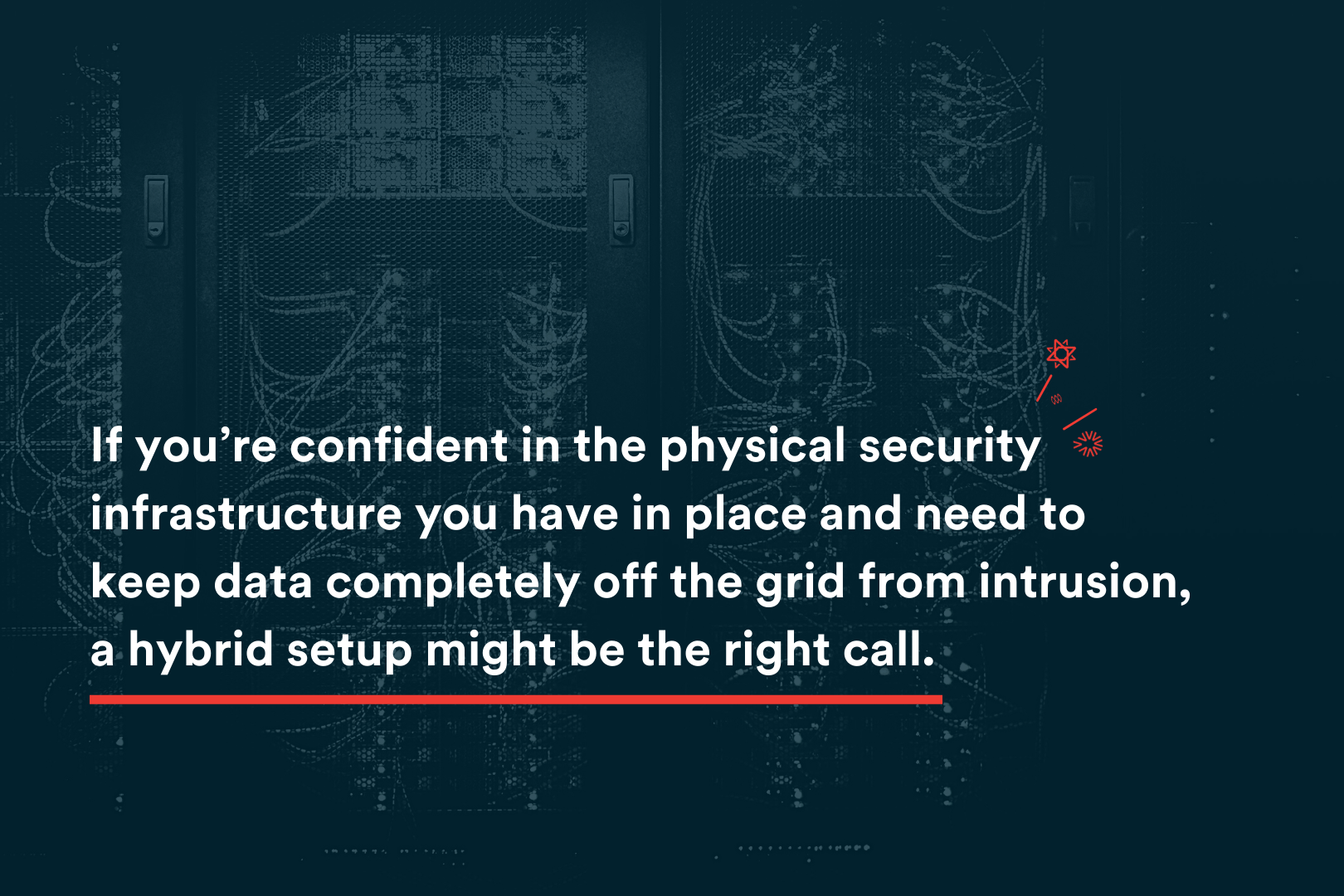Cloud infrastructure | Cloud & Hybrid | Cloud Migration
When it comes to data integral to your business and software, you basically have three storage options to choose from:
- On-Premises
- Cloud
- Hybrid
It shouldn’t shock you to learn that on-premises and cloud computing are opposing ends of a spectrum, and hybrid is a combination of the two.
Most businesses are moving at least some of their operations to the cloud. So the answer to your data strategy is less on-premises (i.e. server storage) vs. cloud vs. hybrid, and more just cloud vs. hybrid.
To put it bluntly: the question isn’t whether or not to transition to cloud computing. It’s whether to move all or some of your data to the cloud.
Let’s look a little more closely at cloud vs. hybrid computing and explore some scenarios where your organization may opt for one over the other.

Cloud Computing
A fully cloud-based service offering is what would occur if your organization decides to transfer all of its data and operations to cloud-based platforms. In this scenario, you would no longer need to have a server stored on site unless you wanted to keep one around as a redundancy to back up certain key information (even this isn’t necessary, however, as basically every reputable cloud provider will have similar safeguards in place to protect data). You’ll experience many benefits from migrating to the cloud.
- Security
Having all of one’s data in an on-site server carries critical security risks. You must take steps to keep the space safe from intruders and cyber threats, and you also have to worry about re-occurring issues like power outages, floods, fires, etc. Moving to the cloud removes these types of security risks and lets you benefit from the security parameters of the world’s leading tech companies. - Speed
Without the need to draw data from a physical location that might be hundreds or thousands of miles away from your employees, users, or customers, the speed of your applications and operations can be dramatically improved. - Accessibility
When operations move to the cloud, your users can theoretically connect from anywhere with internet access (assuming you want them to have those privileges). - Scalability
There may come a time when all the data powering your organization simply can’t be contained within an on-premises setup. Transitioning to the cloud enables you to scale your business, knowing that you can continue to scale later on as you grow.
For all these reasons and more, many companies and government entities have made the decision to migrate their services and ops to the cloud. Doing so is not without short-term disruption, but the long-term benefits of doing so more than outweigh any temporary struggles that might result from aligning the business around a cloud-based strategy.
Hybrid
A hybrid data strategy is exactly what it sounds like: you’re transitioning some of your data to the cloud while keeping some portion of the data in an on-site capacity.
Organizations have a variety of reasons to utilize a hybrid approach to their data.
- Security
Just as an organization may transfer their data to the cloud for security purposes, so too might a company or department elect to keep some sensitive data stored on-site for similar security reasons. If you’re confident in the physical security infrastructure you have in place and need to keep data completely off the grid from intrusion, a hybrid setup might be the right call. - Redundancy
Some places might elect to keep and continue upgrading their on-site servers so they have redundancies in place in the event their data is breached or lost. - Transition at Scale
Some organizations are sufficiently large that the transition to a cloud is a complex and massive undertaking that could take years to fully complete. In this scenario, maintaining on-site data until you can be fully confident the transition is complete may be a necessity. - Segmented Operations
You might encounter a scenario where some of your operations are best served being transitioned to the cloud while others are not. A good example would be data powering customer-facing applications versus data related to employee-only applications. In these situations, you could use some combination of cloud and on-site storage to accommodate the best practices of different business operations.
In these scenarios and more, business and government organizations may elect to keep at least some version of a physical server in place.

What's the Right Setup for You?
Choosing a cloud or hybrid setup for your organization is one of the most important decisions you can make, but you also shouldn’t overthink it.
No decision is ever set in stone. Not only can you decide to move to the cloud, but you can also move back if need be. And if you’ve chosen one cloud provider and aren’t happy with the results, you can always move between providers.
Some organizations put off innovation because of concerns about security, impact on operations, and any of the other results we highlighted above. But with the right approach to strategy and an advisor who’s willing to be open and honest about the strengths and weaknesses of cloud and hybrid setups, you can have confidence that your decisions will be well-informed and have a lasting positive impact for your business.
It’s hard to know the exact right setup without knowing the exact needs of your business, but the most important thing you can do right now is to start the conversation in the first place. This will put you on a path to securing your data and ensuring your business is poised for success.
Let’s talk about how your journey to a cloud or hybrid setup can commence.





